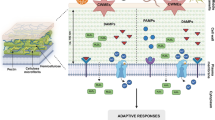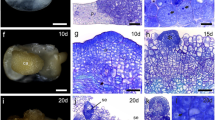Abstract
Pericarp structure and permeability in Tilia miqueliana were explored using anatomy, paraffin section detection, scanning electron microscopy, and magnetic resonance imaging. The pericarp of intact T. miqueliana seeds comprised an exocarp, mesocarp, and endocarp. The exocarp was densely covered with villi and consisted of irregular thin-walled cells. The mesocarp was highly lignified and impermeable, with slender, thick-walled, round and irregularly polygonal cells. The endocarp consisted of spherical parenchyma cells. The water gap provided an entry point for free water in intact seeds. The impermeable and highly lignified mesocarp creates a mechanical and permeability barrier, inhibiting germination in T. miqueliana. Liquid chromatography–mass spectrometry was used to identify the chemical composition of the pericarp. Identified compounds included phenols, esters, organic acid, lipids, aldehydes, as well as unsaturated fatty acids, which likely play a role in suppressing germination.







Similar content being viewed by others
Availability of data and material
All data generated or analysed during this study are included in this published article.
References
An W, Zhang J (1995) Removal of seed germination inhibitors. China Forest Prod 4(04):32
Battle JP, Whittington WJ (1969) The relation between inhibitory substances and variability in time to germination of sugar beet clusters. J Agric Sci 73(3):337–346
Feng J, Shen Y et al (2017) Changes in seed germination ability, lipid peroxidation and antioxidant enzyme activities of Ginkgo biloba seed during desiccation. Forests 8(8):286
Gao B, Xin Y (2015) Research progress on Dormancy mechanism and germination promotion of Tilia seeds. Spec Econ Anim Plants 18(11):37–38
Garnczarska M, Zalewski T et al (2007) Water uptake and distribution in germinating lupine seeds studied by magnetic resonance imaging and NMR spectroscopy. Physiol Plant 130(1):23–32
Guo C, Shen Y et al (2018) Investigating seed dormancy in Pinus bungeana Zucc. ex Endl.: understanding the contributions of enclosing tissues and temperature on germination. Forests 9(7):401
Han W (2012) Study on chemical constituents of Stellera chamaejasme root. Inner Mongolia University. http://cdmd.cnki.com.cn/Article/CDMD-10126-1012440911.htm. https://doi.org/10.7666/d.y2147008
Hu Y, Duan T et al (2010) LC–MS characteristics of the chemical components of the pericarp of Illicium and its significance in classification and identification of medicinal materials. Chin J Tradit Chin Med 35(14):1836
ISTA (2013) International Rules for Seed Testing the International Seed Testing Association (ISTA). Basserdorg
Kockemann A (1934) Uber eine keimungshemmende Substance in fleischigen Fruchten. Ber Deut Bot Ges 52:523–526
Kong X (2002) Inhibiting substance and seed dormancy. J Longyan Teach Coll 20(6):50–52
Li J, Zheng R et al (1996) The role of abscisic acid and phenolic acid in seed dormancy of Korean pine. J Heibei For College 11(3):189–194
Luo L, Wang F, Zhao K, Ye Y (1990) Experimental study on rapid germination and seedling raising of Tilia amurensis seeds. J Northeast For Univ 18(02):103–108
Magherini R, Nin S (1992) Experiments on seed germination of some Tilia spp. WOCMAP I-Medicinal and Aromatic Plants Conference: part 3 of 4 331
Magherini R, Nin S (1994) Propagation of selected Tilia spp. by seed and semihardwood cuttings. Adv Hortic Sci 8(02):91–96
Nurhayani FO, Wulandari AS et al (2019) Morphology and anatomy of the fruit and seed of Cananga odorata (Lam.). Hook. f. & Thomson. Biodiv J Biol Diver 20(11):3199–3206
Rashid N, Zafar M et al (2017) Intraspecific variation in seed morphology of Tribe vicieae (Papilionoidae) using scanning electron microscopy techniques. Microsc Res Tech 81(3):298–307
Ruan R, Litchfield JB et al (1992) Simultaneous and nondestructive measurement of transient moisture profiles and structural changes in corn kernels during steeping using microscopic nuclear magnetic resonance imaging. Cereal Chem 69(6):600–606
Shi F (2006) Biological characteristics and dormancy mechanism of Tilia amurensis seeds. Nanjing Forestry University, Nanjing
Shi F, Shen Y et al (2007) Study on germination inhibitor of Nanjing Linden seeds. J For Environ 27(3):222–225
U.S. Department of Agriculture, Bureau of Forestry (1984) Seed manual of woody plants in the United States. Translated by Li Ting, China Forestry Press, Beijing
Vanstone DE, Ronald WG (1982) Seed germination of American basswood in relation to seed maturity. Can J Plant Sci 62(3):709–713
Wang H (2012) Study on dormancy mechanism and dormancy release technology of Tilia amurensis seeds. Northeast Forestry University
Wareing PF (1965) Endogenous inhibitors in seed germination and dormancy. In: Differenzierung und Entwicklung/Differentiation and development. Springer, Berlin, Heidelberg, pp 2556–2571. https://doi.org/10.1007/978-3-642-50088-6_64
Xiao Q (2019) Study on the chemical constituents and biological activities of ethyl acetate from Stellera chamaejasme. Northwest University of Agriculture and Forestry Science and Technology. http://cdmd.cnki.com.cn/Article/CDMD-10712-1019845448.htm
Yang J, Ye W et al (2003) Causes of seed dormancy and pleomorphism of dormancy. Acta Bot Boreal Occident Sin 23(5):837–843
Yang X, Zhang P et al (1997) Relationship between phenols content and dormancy of Hawthorn Seeds. Acta Hortic Sin 24(4):393–394
Yao W, Shen Y (2018) Effects of gibberellic acid and magnetically treated water on physiological characteristics of Tilia miqueliana seeds. Can J For Res 48(5):554–558
Yao WF, Shen YB et al (2015) Germination of Tilia miqueliana seeds following cold stratification and pretreatment with GA3 and magnetically-treated water. Seed Sci Technol 43(3):554–558
You X (2006) Study on adaptability, propagation technology and economic value of introduction of Acer cork and Tilia amurensis. Beijing Forestry University, Beijing
Zhao T, Qian C et al (2019) Germination inhibitors detected in Sapium sebiferum seeds. J For Res 30(6):2305–2312
Acknowledgements
We would like to thank the College of Forestry, Nanjing Forestry University, and Co-innovation Center for Sustainable Forestry in Southern China, Southern Tree Inspection Center National Forestry Administration.
Funding
This work was supported by the Priority Academic Program Development of Jiangsu Higher Education Institutions (PAPD).
Author information
Authors and Affiliations
Contributions
Y.B.S. conceived the original screening and research plans; Y.W. performed the experiments using the MRI, SEM, and PSD methods; Y.W. designed the experiments and analyzed the data; Y.W. conceived the project and wrote the article with contributions of all the authors. Y.W. agrees to serve as the author responsible for contact and ensures communication. All authors have read and approved the manuscript.
Corresponding author
Ethics declarations
Conflict of interest
The authors declare that they have no competing interests.
Ethical standards
We strictly comply with the Convention on the Trade in Endangered Species of Wild Fauna and Flora, and also abide by Law of the People’s Republic of China on Wildlife Protection. Research permission on Tilia miqueliana tree has been obtained from Jiangsu Wildlife Protection Station. The collection of experimental intact seeds was approved by the Management Office of Huang Zangyu National Forest Park in Anhui Province, China.
Additional information
Publisher's Note
Springer Nature remains neutral with regard to jurisdictional claims in published maps and institutional affiliations.
Electronic supplementary material
Below is the link to the electronic supplementary material.
Rights and permissions
About this article
Cite this article
Wu, Y., Shen, Y.B. The structural and chemical characteristics of the pericarp are important in Tilia miqueliana seed dormancy. New Forests 52, 875–888 (2021). https://doi.org/10.1007/s11056-020-09820-3
Received:
Accepted:
Published:
Issue Date:
DOI: https://doi.org/10.1007/s11056-020-09820-3




